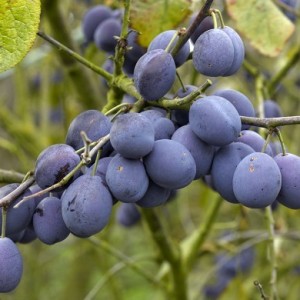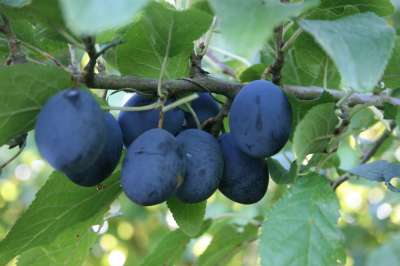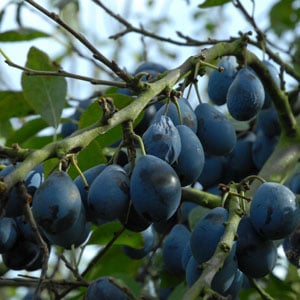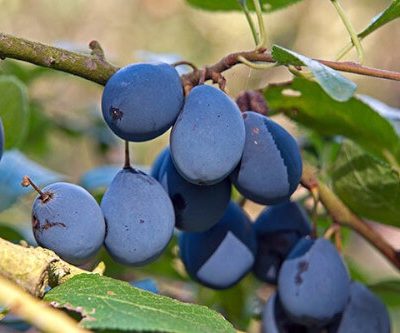Your basket is currently empty!
The Damson Fruit Tree
The Damson fruit tree is a very old fruit that originates from Northern Europe; it is a hardier bet than the Plum for less favourable positions and has traditional associations with Cumbria where ‘Damson Day’ is still held in celebration of this fruit. It is said to tolerate wetter soils than the Plum though it should be stressed it won’t appreciate sitting in water but it can nevertheless be considered for less ideal situations.
That is not to say the Damson deserves relegation to some dark and dingy corner simply because no other fruit tree will grow there; it truly deserves celebration and Damsonphiles will sing perennially of the unmistakeable, full-on powerful taste that is quite unlike any other fruit. Damsons aren’t really suitable for eating raw – cooking brings out the full depth of flavour and allows for some sugar to be added. Damson jam is without compare, they are heavenly simply stewed and served with custard or cream, and you can also make pies and crumbles. They freeze very well. The fruit and stones are smaller than plums so however they are used in the kitchen it is customary to remove the stones after cooking where possible, as trying to stone the fruits before use is a near-impossible and thankless task!

Wide range of Damson trees available by clicking HERE
Most Damsons are self fertile so can be grown alone and although the tree itself is hardy and reliable, the blossom comes very early so can still be prone to frost damage the same as plums and gages.The selection of varieties is quite small but serviceable and there are growing forms that answer most requirements.
Rootstock selection
As with most fruit trees, Damsons are grafted [a type of propagation] onto a rootstock that determines the vigour of the tree. The correct choice of rootstock is the most important aspect of selecting the right tree for you.
St Julien
St Julien is a moderately vigorous tree that imparts added hardiness and suits most applications. It can be expected to reach 10-14’ and will usually start to yield from year three. Ideal for a bush tree, half standard or fan training. It is the rootstock most used for orchard planting and is also ideal for grassland, larger lawn or paddock. Plant 10’ apart.
Pixy
This dwarfing stock revolutionised the growing of plums, gages and damsons in gardens and brings these fruits within the scope of all. Pixy can even be grown in a container, it is ideal for growing as a small bush tree or column. It is less suited to fan training. Can be controlled to 6-8’, plant 8’ apart [less in a pot] Precocious, as dwarfing trees often are and will often yield from year two.
Brompton
Super-vigorous and unsuited to gardens being more of value for paddock, open grassland and for use where animals graze or for traditional orchards where a very large tree is required. Can reach 20’ in height so ladders are required for harvesting or most of the fruit will be out of reach. A very hardy rootstock which takes 4-5 years to reach cropping age.
Wanghenheimer
A rootstock that is less used in this country but popular in Europe. Intermediate in size between Pixy and St Julien so could be described as semi-dwarfing. Likes most soils.
Growing methods for Damson trees
The bush tree Depending on the rootstock chosen is suitable for an open position, large mixed border, lawn, orchard or wherever a free standing tree is required. The heaviest crops are achieved from bush trees; if you need to mow beneath the tree then choose St Julien, or Brompton for a very vigorous tree.
Fan training
If you want to grow your Damson against a wall then you will want to fan train it. This method gives an attractive shape and the tree hugs the wall. Because Damsons are very hardy even a North or East wall can be utilized and you will need an area 6-8’ in height and the same in width for one tree.
The column growing method
This is the most space-saving option of all and can be incorporated anywhere there is 2-3’ of space because that is all that is required. The tree is kept as a simple single-stemmed tree with numerous short side shoots that bear the fruit. The pruning method is quite simple and easy to understand, crops appear all up the stem and this growing method is quite precocious, often bearing fruit from year two. Also suitable for a container, spread around the garden border or along a walkway as you wish. Ideal for planting against pillar, post or arch. You can also plant the trees close together at the optimum distance and allow to grow together as a ‘hedge’
Flowering & Pollination
The blossoms of Damson trees are small, single and off white. They crowd the branches from early April. Most varieties of Damson are self fertile so you only have to grow one; the also cross pollinate with Plums and Gages and can be used to help fertilize them and vice versa.






